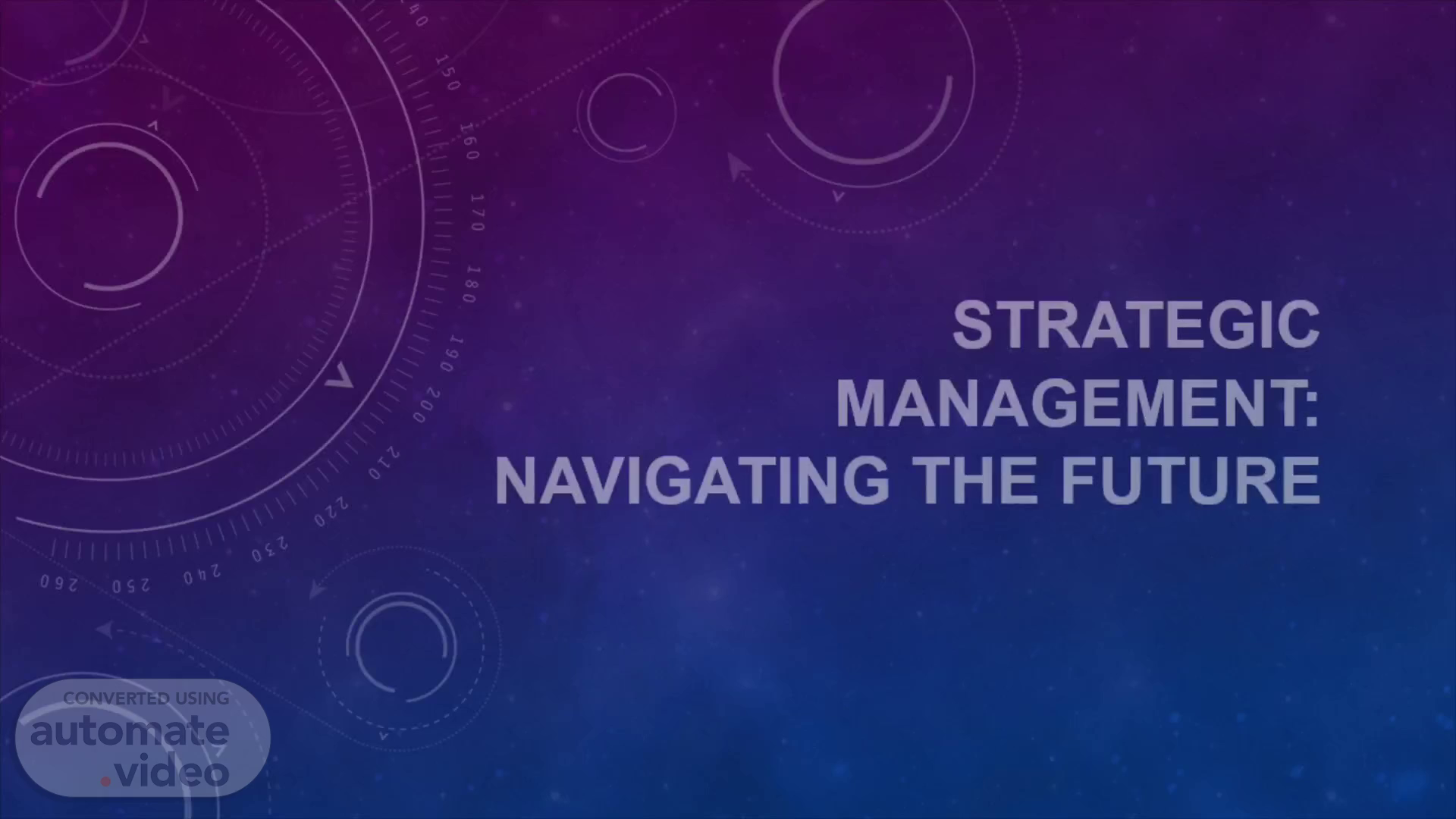
Strategic Management: Navigating the Future
Scene 1 (0s)
[Audio] Welcome to Topworker .In this presentation, we will explore the key concepts, components, and processes involved in strategic management..
Scene 2 (10s)
[Audio] Strategic management is a vital practice for organizations. Let's break down what it involves: Setting Goals and Objectives: Strategic management begins by defining clear goals and objectives that guide the organization's actions. Analyzing Internal and External Factors: It involves identifying and assessing internal strengths and weaknesses, as well as external opportunities and threats. Formulating and Implementing Initiatives: Strategic management goes beyond planning; it also involves creating and executing strategies to achieve the organization's objectives..
Scene 3 (54s)
[Audio] Why is strategic management crucial for any organization? Aligning Resources and Vision: It helps align an organization's resources and capabilities with its vision and mission, ensuring everyone is working toward the same goals. Informed Decision-Making: It provides a framework for making well-informed decisions and prioritizing resources effectively. Driving Success: Effective strategic management can lead to increased competitiveness, growth, and overall success in a rapidly changing business landscape..
Scene 4 (1m 32s)
[Audio] Strategic management comprises several key components: Strategic Planning: This involves setting specific goals, defining strategies, and creating detailed action plans to achieve those goals. Execution: Execution is about putting the plans and initiatives into action, ensuring they are effectively implemented. Evaluation: This stage involves assessing the outcomes, measuring performance, and making necessary adjustments based on the results..
Scene 5 (2m 7s)
[Audio] The strategic management process consists of multiple stages. Two key stages to understand are: Strategic Planning: This is the process of defining the organization's direction, setting specific goals, and creating detailed plans to achieve those goals. Strategic Management: It's a broader, ongoing process that encompasses planning, implementation, and evaluation. It involves not only creating a strategy but also executing it and adapting to changing circumstances..
Scene 6 (2m 44s)
[Audio] Let's delve into the first two stages: Analysis: This stage includes conducting SWOT and PESTEL analysis to understand internal and external factors. It involves assessing the competitive landscape and evaluating internal strengths, weaknesses, resources, and capabilities. Formulation: In this stage, organizations: Develop their mission and vision statements. Set clear, measurable strategic objectives. Craft corporate, business, and functional strategies..
Scene 7 (3m 24s)
[Audio] Implementation involves structuring the organization to support your strategies. This is where the strategy takes shape, and execution is critical. Structuring the Organization: Your organizational structure should align with your chosen strategies. This might involve defining roles and responsibilities, creating new departments, or restructuring existing ones. Fostering a Strategy-Aligned Culture: A culture that embraces and supports the strategy is key. Employees should be engaged, motivated, and aligned with the organization's goals. Executing Plans and Allocating Resources: This is where the rubber meets the road. You'll execute your plans, allocate resources, and monitor progress closely to ensure you're on track. Evaluation: [Visual: Bullet points for Evaluation] Narrator: The Evaluation stage is about assessing how well your strategy is performing. Measuring Performance with KPIs: Key Performance Indicators (KPIs) are used to measure various aspects of your strategy. They provide quantifiable data to assess effectiveness. The Balanced Scorecard: The Balanced Scorecard is a holistic evaluation framework that looks at different aspects of your strategy, including financial, customer, internal processes, and learning and growth perspectives. Refining and Adapting: The data gathered from performance measurements is not just for record-keeping. It's a valuable tool for refining and adapting your strategy. If something isn't working as expected, you have the insights needed to make informed adjustments. Together, these stages create a cycle where you continuously implement, evaluate, and refine your strategies to ensure they remain effective and aligned with your organizational goals. This ongoing process is essential in the ever-evolving business landscape..
Scene 8 (5m 39s)
[Audio] Strategic formulation is where the foundation for your strategy is built. Developing a Mission and Vision: A mission statement defines the organization's purpose, stakeholders, and core activities. A vision statement outlines long-term aspirations, inspiring and motivating the team. Setting Strategic Objectives: Objectives are specific, measurable, and time-bound goals aligned with the mission and vision. They serve as a clear roadmap for evaluation and success. Crafting Strategies: Corporate, Business, and Functional: Corporate strategy sets the overall direction, addressing diversification and scope. Business strategy focuses on how a unit or product line competes. Functional strategies tailor departmental approaches to support broader goals..
Scene 9 (6m 38s)
[Audio] Strategic management is aided by various tools to make informed decisions. SWOT analysis identifies internal strengths and weaknesses, as well as external opportunities and threats. PESTLE analysis assesses political, economic, social, technological, legal, and environmental factors. Other tools include Porter's Five Forces, scenario planning, and balanced scorecards..
Scene 10 (7m 7s)
[Audio] Thank you for joining us in this exploration of strategic management..